【Go Programming Language 2】
1、In Go, the sign of the remainder is always the same as the sign of the dividend, so -5%3 and -5%-3 are both -2. The behavior of / depends on whether its operands are integers, so 5.0/4.0 is 1.25, but 5/4 is 1 because integer
division truncates the result toward zero.
2、bitwise operator
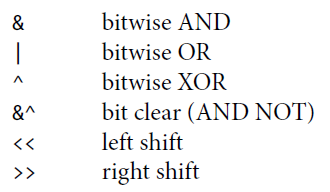
The &^ op erator is bit cle ar (AND NOT): in the expression z = x &^ y, each bit of z is 0 if the corresponding bit of y is 1; otherwise it equals the corresponding bit of x.
3、Printf 的高级用法。

the [1] ‘‘adverbs’’ after % tell Printf to use the first operand over and over again. Second, the # adverb for %o or %x or %X tells Printf to emit a 0 or 0x or 0X prefix respectively.
4、Runes are print ed wit h %c, or with %q if quoting is desired:

5、math.NaN()
Any comparison wit h NaN always yields false:

6、Complex Numbers

3.141592i & 2i is an im aginary literal, denoting a complex number wit ha zero real component:
complex literal:

7、strings
Either or both of the i and j operands may be omitted, in which case the defau lt values of 0 (the start of the string) and len(s) (its end) are assumed, respectively.

Since strings are immutable, constructions that try to modify a string's data in place are not allowed:

A raw string literal is written `...`, using backquotes instead of double quotes.
8、UTF-8
The high-order bits of the first byte of the encoding for a rune indicate how many bytes follow. A high-order indicates 7-bit ASCII.

No rune’s encoding is a substring of any other, or even of a sequence of others, so you can search for a rune by just searching for its bytes.
The unicode package provides functions for working with individual runes , and the unicode/utf8 package provides functions for encoding and decoding runes as bytes using UTF-8.
utf8.RuneCountInString() 可以获取一个 utf8 字符串中的字符个数。

utf8.DecodeRuneInString(str) 可以解析出第一个utf8字符,如下:

使用 range 遍历utf8字符串,range会自动调用 DecodeRuneInString()方法进行解码。

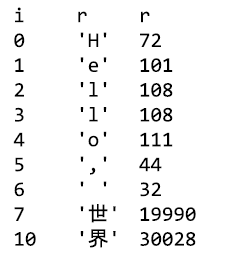
因此,可以使用 range 来统计字符串长度。下面右图是左图的精简版,忽略了 range 的返回值。
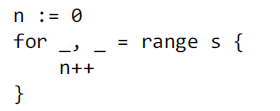
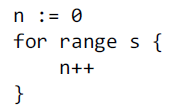
也可以调用 utf8.RuneCountInString(s) 来获得 utf8 字符串的长度。
[]rune(utf8_str) 可以返回 utf8 字符串的 unicode code point.

9、Because strings are immutable, building up strings incrementally can involve a lot of allocation and copying . In such cases, it's more efficient to use the type bytes.Buffer.
basename() 移除路径、以及扩展名。

10、A string contains an array of bytes that, once created, is immutable. By contrast, the elements of a byte slice can be freely modified.
Strings can be converted to byte slices and back again:

11、strconv.Itoa() 用于转换。

12、FormatInt and FormatUint can be used to format numbers in a different base.

fmt.Printf verbs %b, %d, %u, and %x are often more convenient than Format functions,especially if we want to include additional information besides the number:

strconv.Atoi()、strcov.ParseInt() 用于将str 转换为 int。

13、单个常量

多个常量

14、const generator iota
Below declares Sunday to be 0, Monday to be 1, and so on.

As iota increments, each constant is assigned the value of 1 << iota, which evaluates to successive powers of two, each corresponding to a single bit.

15、Untyped Constants
many constants are not committed to a particular type.
The compiler represents these uncommitted constants with much greater numeric precision than values of basic types, and arithmetic on them is more precise than machine arithmetic; you may assume at least 256 bits of precision.
16、Arrays are homogeneous—their elements all have the same type—whereas structs are heterogeneous. Both arrays and structs are fixed size. In contrast, slices and maps are dynamic data structures that grow as values are added.
Array 中所有元素必须有相关的 type。Array、struct 固定大小,slice、map 动态大小。
17、使用 array literal 初始化 array.

上述代码,两个3重复了。所以也可以使用 := 以及 ... 来编译器推导array 长度。

[3]int and [4]int are different types.

array literal 中可以设定索引来定义。

Below defines an array r with 100 elements, all zero except for the last, which has value -1.

18、array 的相等性比较,使用的是其内所有元素的相等性比较。

19、Slice
Slices represent variable-length sequences whose elements all have the same type. A slice type is written []T, where the elements have type T; it looks like an array type without a size.
Slicing beyond cap(s) causes a panic, but slicing beyond len(s) extends the slice, so the result may be longer than the original.
Passing a slice to a function permits the function to modify the underlying array elements.
通过 slice 可以修改 array中的元素。


20、A simple way to rotate a slice left by n elements is to apply the function three times, reverse first to the leading n elements, then to the remaining elements, and finally to the whole slice.

Unlike arrays, slices are not comparable, so we cannot use == to test whether two slices contain the same elements. The only legal slice comp arison is against nil, as in:

注意区分 slice 的定义和创建。定义一个slice,其值为nil;创建一个slice,其值为非nil。

The built-in function make creates a slice of a specified element type, length, and capacity。

21、内置的 append(slice, value) 函数有可能会创建一个全新的slice。

1 func appendInt(x []int, y int) []int{ 2 var z[]int 3 zlen:=len(x)+1 4 if zlen<=cap(x){ 5 z = x[:zlen] 6 }else{ 7 zcap:=zlen 8 if zcap<2*len(x){ 9 zcap=2*len(x) 10 } 11 z=make([]int,zlen,zcap) 12 copy(z,x) 13 } 14 z[len(x)]=y 15 return z 16 }
因数调用 append() 后,有可能会创建一个全新的 slice,所以通常会将 append() 函数赋值给回自己。如下:

append() 可以添加超过一个元素。

22、slice 可以理解为如下结构
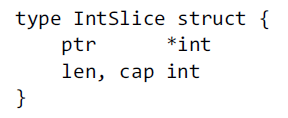
23、使用 ellipsis 可以实现变长参数。如:

24、In-Place Slice Techniques
1)nonempty
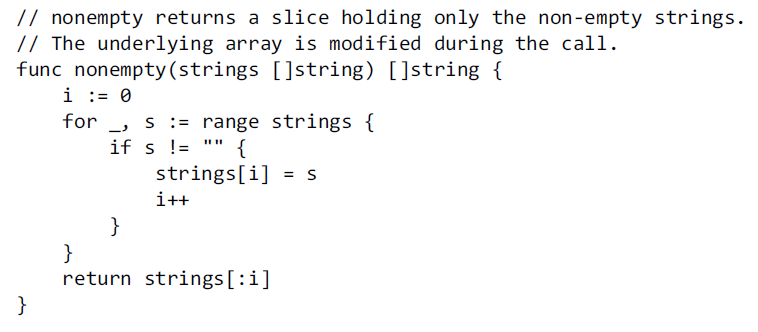
2)
25、slice can be used to implement a stack.
stack = append(stack, v) // push v top:=stack[len(stack)-1] // top of stack stack = stack[:len(stack)-1] // pop
实现从 slice 中移除元素。
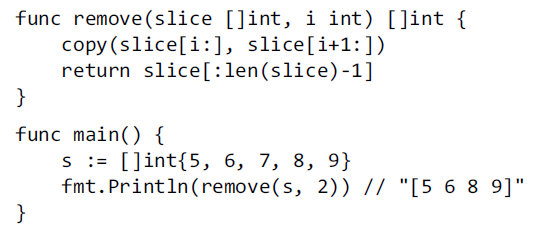
And if we don’t need to preserve the order, we can just mov e the last element int o the gap:

26、maps
In Go, a map is a reference to a hash table, and a map type is written map[K]V, where K and V are the types of its keys and values. All of the keys in a given map are of the same type, and all of the values are of the same type, but the keys need not be of the same type as the values.
![]()
map literal:
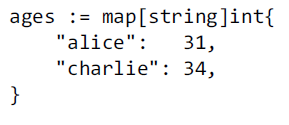
delete() 函数可以移除key。

But a map element is not a var iable, and we cannot take its address:

map[] 方法实际上返回两个元素,第二个元素指明本元素是否有值。

27、Go does not provide a set type, but since the keys of a map are distinct, a map can serve this purpose.
一个map的value可以是另一个map。

28、
29、
30、
